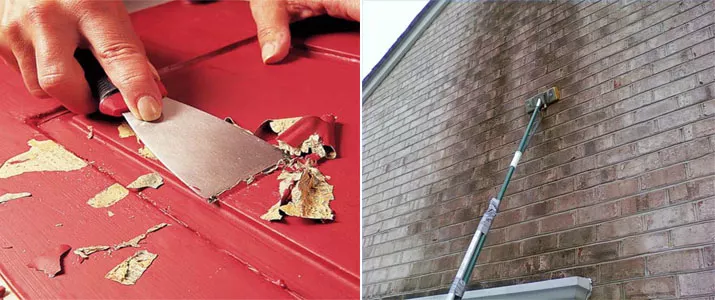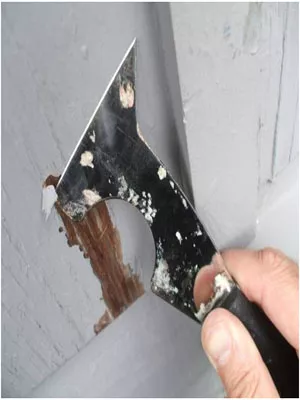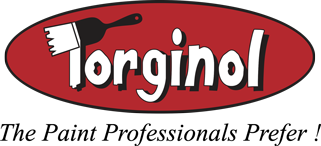GENERAL SURFACE PREPARATION

1.CRACKS, SPLITS AND OPEN JOINTS
Cracks, or open joints, where water may enter, should be sealed with a suitable sealant. Apply primer over the sealed area.
2.DIRT, GREASE, OIL,CHALK AND UNDER-EAVE DEPOSITS
Remove these deposits by washing with a detergent solution (TSP) or commercial cleaner recommended for cleaning painted surfaces using a sponge or brush. Protected areas, such as under eaves and overhangs, need special attention to remove invisible deposits that can promote a premature peeling problem. After washing, thoroughly rinse with clean water and allow to dry. Power-washing is also a fast, effective method of removing dirt, chalk, etc. If a power-washer is used, follow the manufacturer’s recommendations and warnings.
3.GLOSSY SURFACES
Always dull surfaces with sandpaper when painting a glossy surface to promote adhesion.
4.LOOSE AND PEELING PAINT
Remove as much loose and peeling paint by scraping, wire brush or power-washing the surface. Feather-sand rough edges smooth until they blend with bare surface.
5.MILDEW
Spotty patches that look like dirt, but do not come off when scrubbed with detergent solution, are probably mildew. Mildew can occur on any side of the house, but is more likely to grow in shaded areas or behind shrubbery. It can easily be identified from other forms of discoloration by applying a few drops of bleach. If mildew is present, the black, gray or brown color will bleach out and disappear within one or two minutes. Mildew must be killed and removed before repainting. If the mildew is not completely removed, the active spores will continue to grow and may almost immediately begin to reappear on a recently repainted surface. Where mildew is present, apply a solution of one part household bleach and three parts water, or use a commercial mildew remover. It is mandatory to wear rubber gloves, goggles, long-sleeved shirt and long pants to protect eyes and skin when using a mildew remover. In addition, protect grass, trees and shrubs with plastic covers.
CAUTION!! DO NOT MIX BLEACH WITH AMMONIA OR DETERGENTS CONTAINING AMMONIA. Follow specific instructions if a commercial mildew remover is used.
6.PREVIOUSLY COATED SURFACES
Maintenance painting will frequently not permit complete removal of all old coatings prior to repainting a particular surface. Recognize that any surface preparation, short of removal of all old coatings, may compromise the service life of the new coating system. Check compatibility of previously painted surfaces using a test patch with the coating if there is any doubt on recoatability.
7.RUST
Remove all rust by sandblasting, wire brush, steel wool, sandpaper or by using Arbo Rust Out – Rust Remover.
8.RUSTY/LOOSE NAILS
Replace loose nails with slightly larger, galvanized nails. Leave nail heads flush with hardboard surfaces and counter sink on all other wood surfaces. Prime with Antirus Metal Primer.
9.WAX MIGRATION
This condition can be encountered on hardboard surfaces. If a stain or discoloration persists after removing dirt and/or mildew, it may be a wax migration from the siding. It can be identified by applying a few drops of water, both to a discolored area and an adjacent non-discolored area. If the water beads on the discolored area, but spreads or is absorbed in the areas around the stain, a wax migration condition probably exists in the stained area. In most cases this discoloration can be removed with a hot detergent solution (TSP), followed with a thorough rinsing with clean water. In extreme cases removing the stain by wiping the area with a clean rag, wet with mineral spirits, may be necessary, followed by a detergent solution (TSP) wash and clean-water rinse. Repeating either process may be necessary until clear water ceases to bead up on the affected area. Prime the affected area prior to top coating.

